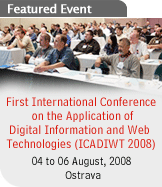 |
 |
| |

Maximize ROI in 5 steps
5th December 2007
ROI is currently the hottest theme in the sector. Event organisers are now challenged to justify the investment made in their events. Here are 5 steps to measure just that.
Return on Investment (ROI) is the challenge for today’s event organiser. It’s no longer enough to have the guests saying that they have a good time at your event, but companies want to know what have they achieved when they organised an event and if their objectives for the event have been met.
Every event starts with its objectives. And we are not talking about knowing if the guests enjoyed the catering and have a good time during the event. Event organisers today have to justify the expenses spent in the event and how they have met the objectives, and this goes beyond a simple questionnaire to be filled out by the guests at the end of the event. From a simple cocktail to a convention to an incentive program, event organisers need to show the success of their event.
Here are 5 steps to start:
1. Define all goals and objectives.
Measuring ROI is difficult because the factors that should be considered are numerous and can vary from company to company and program to program. Every event has been organised to achieve something: be it to communicate certain values of the company or product, if the event has helped to increase sales or increase the motivation of the people involved, it is important to define the goals and objectives and setting the measurement parameters to see if they have been achieved.
Goals and objectives can be both quantitative and qualitative. Defining them and making them measurable are essential and should be defined right at the beginning of the entire organisation process.
Quantitative objectives are normally easier to measure since we are talking about the increase or decrease in certain factors such as the increase in sales or the decrease in expenses.
Qualitative objectives are intangible and are harder to measure but you can still put in certain measures to quantify the results such as for example, the motivation level of an incentive program by introducing a ranking system in the satisfaction level of the group in the program, the likelihood in purchasing the product after the presentation, etc.
By making the objectives and goals as concrete and as measurable as possible help to justify if the investment made in the event is good and what actions should be introduced in the event program to make the measurement possible.
2. Get essential parties to participate.
All parties involved in the event can help give their input in what they are looking for in the event. Ask who are the people that can help to achieve the goal, should sales support and customer service be involved… Leaving one of these key parties out at the beginning could be detrimental later on.
Many times, one simple goal will need the participation of other department or parties to make the measurement possible.
For example, when an agency is involved in organising the event, the agency should be brief what are to be measured and help to implement any actions to make the measurement possible.
3. Identify potential pitfalls.
It is seems sufficient to set the parameters in place for measuring the returns. But it is also important to know what are the factors that can deter the measuring to take place. Not having staff to give out feedback forms or forms that take eternal to fill out, or systems in place to enter the data to generate the necessary reports can make the measurement impossible.
4. Monitor and track all data.
No matter what tools you are using to measure and analysis the data, the data you garner will ensure you to keep the focus on the key indicators that were defined when the program was established. Ensure the accuracy of data input and do not miss out any details where you will need to go back to the attendees to ask for it again. Ensure that whatever data that you are tracking can be related back to measuring the goals and objectives that you have set at the beginning.
5. Communicate the results.
Keep all parties involved informed about the results. A written report complete with spreadsheets, is probably the quickest and easiest way to collect and store data. However, making a more visually appealing report helps everyone "see" the progress and potentially creates more proponents of your plan.
Put the results in a central location where the parties involve can easily access it. And if the results can be communicated in different progress, especially for a program that runs over a period of time, update it regularly.
|
| << Back
to browsing |
|
|
 |
 |
|
|
 |
|

|
 |
14th International Sindhi Sammelan
Thanks to EventAvenue, we received an overwhelming response for an event. Our guests were extremely pleased with our new easy registration process. And, we even had to turn away guests. more...
- Mr. Deepak Gurnani (President), Singapore Sindhi Association.
|
 |
|

|
|
 |


